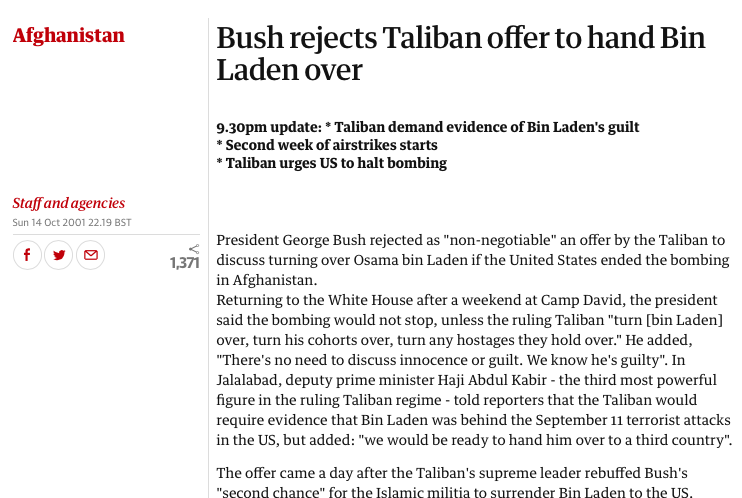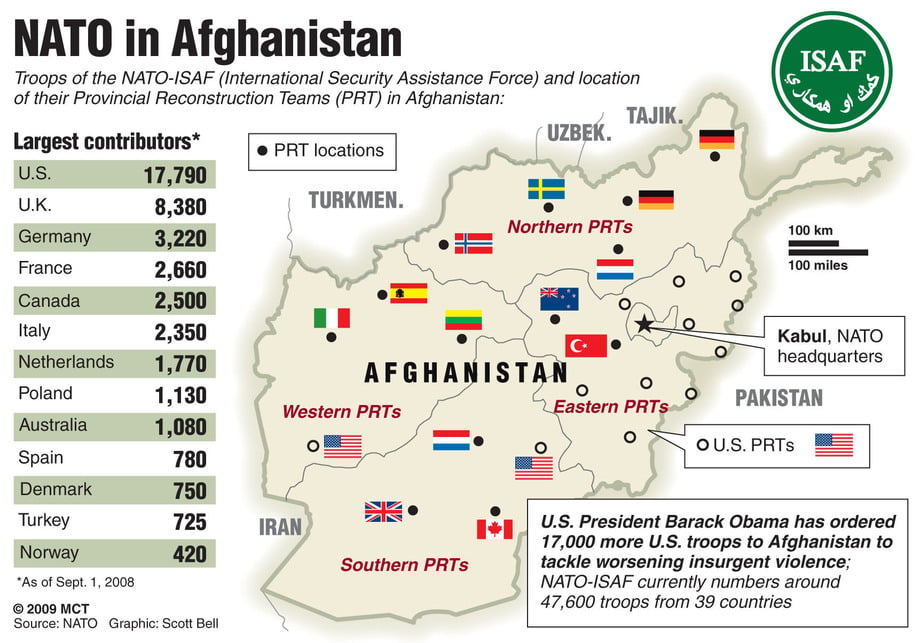More American Troops to Afghanistan, To Keep the Chinese Out? Lithium and the Battle for Afghanistan’s Mineral Riches

This article was first published by GR on September 18, 2017
Barely a few months ago (August 2018), Trump was calling for an escalation of the war in Afghanistan. Why?
It was presented to public opinion as part of America’s “Global War on Terrorism”, going after the bad guys.
And now Trump is calling for the withdrawal of US troops. Will it take place?
Why were US-NATO troops sent to Afghanistan on October 7, 2001?
The official story is that Afghanistan was a “State sponsor” of Al Qaeda (led by Osama bin Laden) which had attacked the U.S. on September 11, 2001.
Below is the BBC report (December 21, 2018) echoing the official narrative, following Trump’s announcement that some 7000 US troops will be leaving Afghanistan.
screenshot of BBC report, December 21, 2018
The above statement by the BBC December 21, 2018) is a lie.
Reported by the Guardian, (October 14, 2001) the Afghan government had offered to extradite Bin Laden to a third country.
In fact there were negotiations on his extradition in mid to late September 2001 extending into the first week of US-NATO bombings in October 2001. Bush refused to negotiate.
The invasion of Afghanistan had been on the drawing board of the Pentagon months prior to 9/11.
IT HAD NOTHING TO DO WITH 9/11. The September 11 attacks were used as a pretext and a justification to invade and occupy Afghanistan.
Moreover, military analysts were instructed not to reveal the fact that you do not plan a large scale theater war thousands of miles away in a matter of 28 days. Impossible. (from September 12- October 7, 2001)
The forbidden truth (known and dcoumented) is that Osama bin Laden was an US intelligence asset and that his precise whereabouts prior and in the immediate wake of 9/11 were known to the US government.
Under NATO’s doctrine of collective security (Art. 5 of the Washington Treaty), a foreign power and state sponsor of terrorism namely Afghanistan had attacked America, despite the fact that the Taliban government had offered to extradite Osama bin Laden to the U.S. if a formal request were to be submitted.
This alleged attack by Afghanistan was used to mobilize NATO member states to participate in the invasion. Article 5 of the Washington Treaty states that “an attack on one member of NATO is an attack on all of its members”. The invasion and occupation was waged on the grounds of “self-defense” against Afghanistan, which had attacked America on September 11, 2001.
The invasion and occupation was part of America’s imperial design. The 9/11 attacks allegedly by Al Qaeda (which is a creation of the CIA) was used to justify the invasion and military occupation of Afghanistan.
Today, there is an ongoing resistance to US military occupation which is led by Taliban forces.
In all likelihood, US military presence will prevail despite Trump’s orders to repatriate several thousand troops.
Michel Chossudovsky, December 22, 2018
***
Unknown to the broader public, Afghanistan has significant oil, natural gas and strategic raw material resources, not to mention opium, a multibillion dollar industry which feeds America’s illegal heroin market.
These mineral reserves include huge veins of iron, copper, cobalt, gold and lithium, which is a strategic raw material used in the production of high tech batteries for laptops, cell phones and electric cars.
The implication of Trump’s resolve is to plunder and steal Afghanistan’s mineral riches to finance the “reconstruction” of a country destroyed by the US and its allies after 16 years of war, i.e “War reparations” paid to the aggressor nation?

Screenshot: The Independent.
An internal 2007 Pentagon memo, quoted by the New York Times suggests that Afghanistan could become the “Saudi Arabia of lithium.” (New York Times, U.S. Identifies Vast Mineral Riches in Afghanistan – NYTimes.com, June 14, 2010, See also BBC, 14 June 2010, see also Michel Chossudovsky, Global Research, 2010).
While it could take many years to develop a mining industry, the potential is so great that officials and executives in the industry believe it could attract heavy investment…
“There is stunning potential here,” Gen. David H. Petraeus, commander of the United States Central Command, said… “There are a lot of ifs, of course, but I think potentially it is hugely significant.”
“This will become the backbone of the Afghan economy,” said Jalil Jumriany, an adviser to the Afghan minister of mines. (New York Times, op. cit.)
What this 2007 report does not mention is that this resource base has been known to both Russia (Soviet Union) and China going back to the 1970s.
While the Afghan government of President Ashraf Ghani has called upon President Donald Trump to promote US. investments in mining, including lithium, China is in the forefront in developing projects in mining and energy as well as pipeline projects and transport corridors.
China is a major trading and investment partner with Afghanistan (alongside Russia and Iran), which potentially encroaches upon US economic and strategic interests in Central Asia
China’s intent is to eventually integrate land transportation through the historical Wakhan Corridor which links Afghanistan to China’s Xinjiang Uyghur autonomous region (see map below).
Afghanistan’s estimated $3 trillion worth of unexploited minerals, Chinese companies have acquired rights to extract vast quantities of copper and coal and snapped up the first oil exploration concessions granted to foreigners in decades. China is also eyeing extensive deposits of lithium, uses of which range from batteries to nuclear components.
The Chinese are also investing in hydropower, agriculture and construction. A direct road link to China across the remote 76-kilometer border between the two countries is in progress. (New Delhi Times, July 18, 2015)

Afghanistan has extensive oil reserves which are being explored by China’s National Petroleum Corporation (CNPC).
Source Mining News, August 2010
“War is Good for Business”
The US military bases are there to assert US control over Afghanistan’s mineral wealth. According to Foreign Affairs, “there are more U.S. military forces deployed there [Afghanistan] than to any other active combat zone”, the official mandate of which is “to go after” the Taliban, Al Qaeda and ISIS as part of the “Global war on Terrorism”.
Why so many military bases? Why the additional forces sent in by Trump?
The unspoken objective of US military presence in Afghanistan is to keep the Chinese out, i.e hinder China from establishing trade and investments relations with Afghanistan.
More generally, the establishment of military bases in Afghanistan on China’s Western border is part of a broader process of military encirclement of the People’s Republic of China.–i.e naval deployments in the South China sea, military facilities in Guam, South Korea, Okinawa, Jeju Island, etc. (see 2011 map below)
Pivot to Asia
Under the Afghan-US security pact, established under Obama’s Asian pivot, Washington and its NATO partners have established a permanent military presence in Afghanistan, with military facilities located close to China’s Western frontier. The pact was intended to allow the US to maintain their nine permanent military bases, strategically located on the borders of China, Pakistan and Iran as well as Turkmenistan, Uzbekistan and Tajikistan.
US military presence, however, has not prevented the expansion of trade and investment relations between China and Afghanistan. A strategic partnership agreement was signed between Kabul and Beijing in 2012. Afghanistan has observer status in the Shanghai Cooperation Organization (SCO).
Moreover, neighboring Pakistan –which is now a full member of the SCO–, has established close bilateral relations with China. And now Donald Trump is threatening Pakistan, which for many years has been the target of America’s “undeclared drone war”.
In other words, a shift in geopolitical alignments has taken place which favors the integration of Afghanistan alongside Pakistan into the Eurasian trade, investment and energy axis.
Pakistan, Afghanistan, Iran and China are cooperating in oil and gas pipeline projects. The SCO of which Turkmenistan, Uzbekistan and Tajikistan are full members is providing a geopolitical platform for the integration of Afghanistan into the Eurasian energy and transport corridors.
China is eventually intent upon integrating Afghanistan into the transport network of Western China as part of the Belt and Road initiative.
Moreover, China’s state owned mining giant, Metallurgical Corporation of China Limited (MCC) “has already managed to take control of the huge copper deposit Mes Aynak, which lies in an area controlled by the Taliban. Already in 2010, Washington feared “that resource-hungry China will try to dominate the development of Afghanistan’s mineral wealth which would upset the United States”… After winning the bid for its Aynak copper mine in Logar Province, China clearly wants more” (Mining.com)
China and the Battle for Lithium
Chinese mining conglomerates are now competing for strategic control of the global Lithium market, which until recently was controlled by the “Big Three” conglomerates including Albemarle’s Rockwood Lithium (North Carolina), The Sociedad Quimica y Minera de Chile and FMC Corporation, (Philadelphia) which operates in Argentina. While the Big Three dominate the market, China now accounts for a large share of global lithium production, categorized as the fourth-largest lithium-producing country behind Australia, Chile and Argentina. Meanwhile China’s Tianqi Group has taken control of Australia’s largest lithium mine, called Greenbushes. Tianqi now owns a 51-percent stake in Talison Lithium, in partnership with North Carolina’s Albemarle.
This thrust in lithium production is related to China’s rapid development of the electric car industry:
China is now “The Center Of Lithium Universe”. China is already the largest market for electric cars. BYD, Chinese company backed by Warren Buffett, is the largest EV manufacturer in the world and Chinese companies are producing the largest amount of lithium chemicals for the batteries. There are 25 companies, which are making 51 models of electric cars in China now. This year we will see over 500,000 EVs sold in China. It took GM 7 years to sell 100,000 Chevy Volts from 2009. BYD will sell 100,000 EVs this year alone! (Mining.com, November 2016 report)
The size of the reserves of Lithium in Afghanistan have not been firmly established.
Analysts believe that these reserves which are yet to be exploited will not have a significant impact on the global lithium market.







